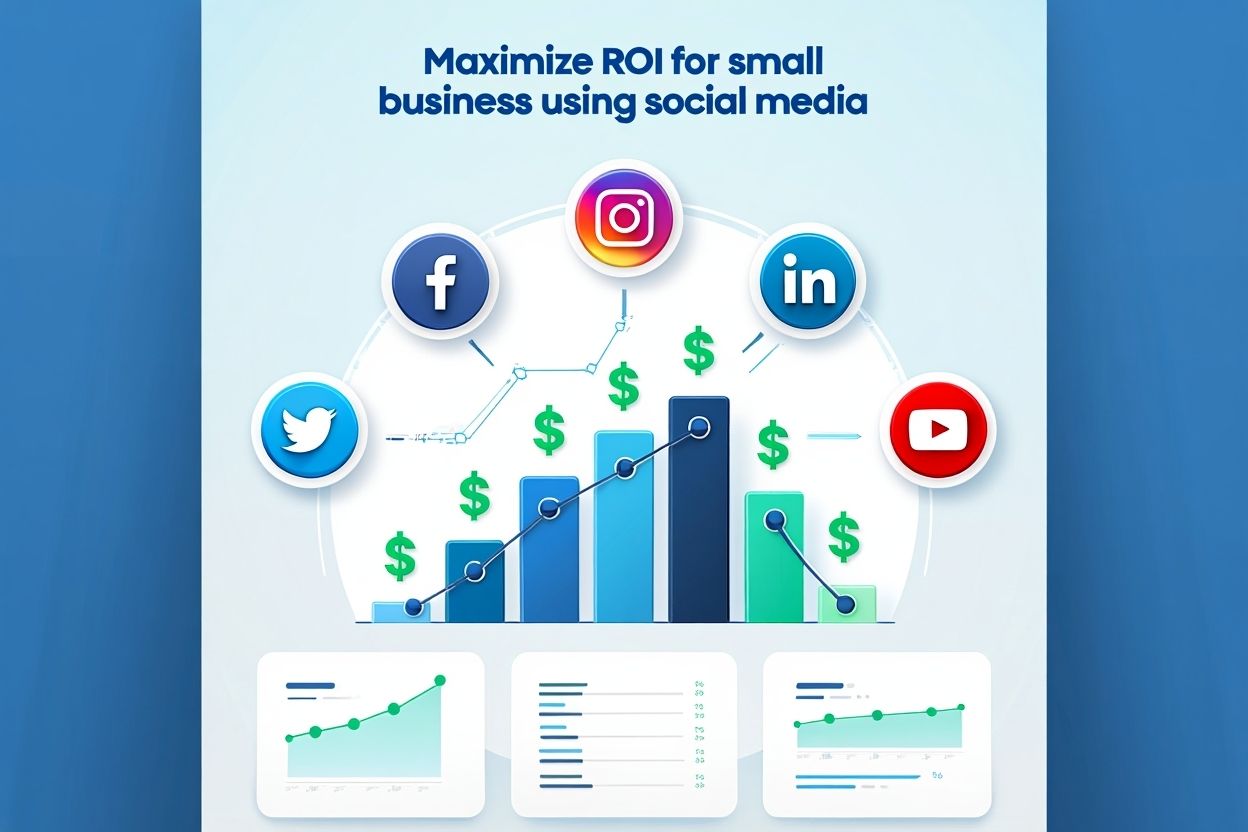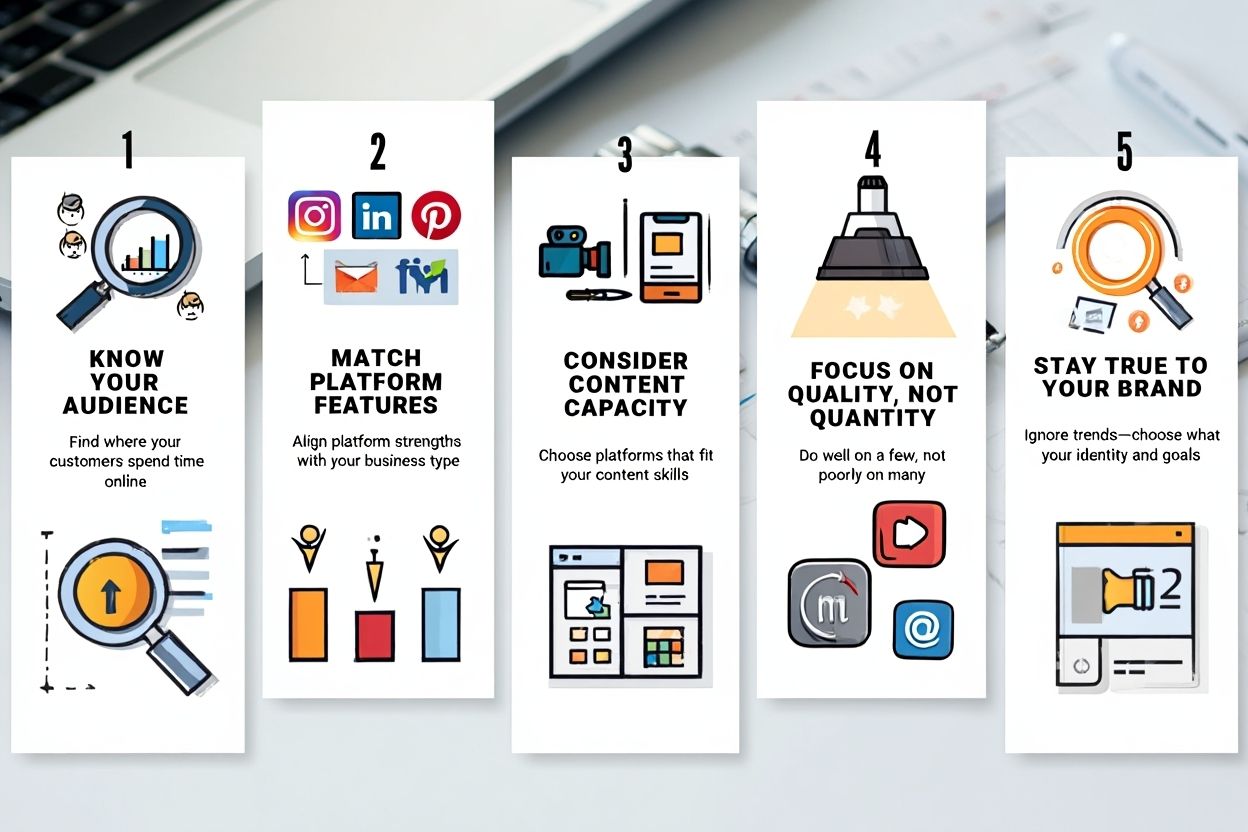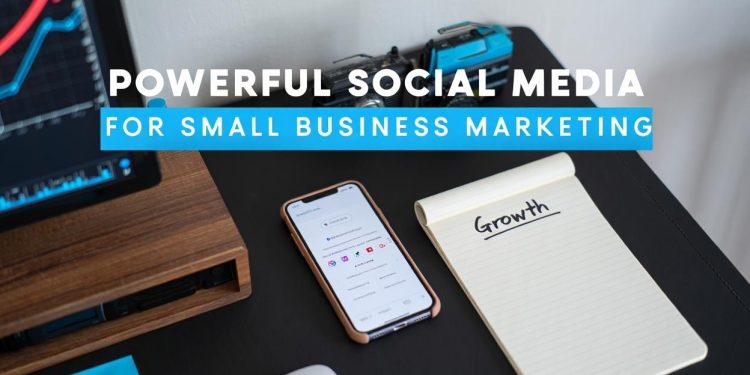Social media for small business marketing means using platforms like Facebook, Instagram, and TikTok to promote products, build brand awareness, and engage customers.
In 2025, this approach is vital because more consumers spend time online, and technologies like AI make marketing smarter and more affordable. Small businesses can now reach local and global audiences without big budgets.
This comprehensive guide breaks down the key benefits, best practices, platform choices, common challenges, and expert tips to help any business succeed with social media.
1. What is social media for small business marketing?
In today’s digital world, understanding the fundamentals of social media for small business marketing is the first step toward business growth.

This section explains what the term means in 2025 and why it’s so crucial for companies of every size.
1.1. A clear definition for 2025
Social media for small business marketing in 2025 involves using online platforms to connect with customers, build trust, and drive sales. Core elements include selecting the right channels, understanding target audiences, and engaging through content and ads.
- Platforms: Facebook, Instagram, TikTok, LinkedIn, and others
- Audience: Local, niche, or broad customers
- Main actions: Branding, sales promotion, customer engagement
Real example:
A local bakery that started in 2023 grew rapidly by sharing behind-the-scenes videos and running targeted Instagram ads. Within a year, they doubled sales and built a loyal online following.
Recent studies show that 75% of small businesses use social media as a key marketing tool, and this number keeps rising.
1.2. Key differences: Small business vs. enterprise social marketing
Not all social media marketing is created equal. Here’s how small businesses and large enterprises typically approach social media, side by side:
| Attribute | Small Business | Enterprise |
|---|---|---|
| Budget | Limited, cost-conscious | Large, dedicated |
| Objectives | Brand awareness, local sales | Global reach, market dominance |
| Audience Targeting | Specific niches, local markets | Broad, segmented groups |
| Tools | Affordable, user-friendly | Enterprise-level software, automation |
| Constraints | Time, expertise, resources | Complex workflows, bureaucracy |
Pro tip:
Focus on your strengths as a small business: authenticity, agility, and community. These can be major advantages over larger, slower competitors.
2. Why use social media for small business marketing?
A strong online presence is no longer optional for small businesses, it’s essential. But why exactly should you invest time and energy in social media for small business marketing?

The benefits go far beyond simply getting likes or follows. Here are over 30 compelling reasons every small business should make social media a core part of their marketing strategy this year:
2.1. Top 30+ benefits in 2025
Before you dive into tactics, let’s explore why social media for small business marketing is indispensable in 2025. The following expanded list shows how it helps drive real results:
- Cost-effective marketing without large ad budgets
- Instant customer communication through messaging and comments
- Hyper-targeted advertising using AI-powered tools
- Real-time feedback to improve products or services
- Boosts local visibility and foot traffic
- Participation in trending topics to remain relevant
- Low startup hurdles with simple profile setups
- Comprehensive analytics to measure success
- Ability to build loyal online communities
- Integration with e-commerce stores for direct sales
- Use of interactive content like polls and quizzes to engage
- Access to a global audience beyond geographic limits
- Brand storytelling through video and live streams
- Opportunity to showcase customer testimonials and reviews
- Supports influencer partnerships for wider reach
- Helps compete evenly with larger businesses
- Ability to adapt quickly to changing market trends
- Supports multi-channel marketing for better results
- Enhanced search engine visibility via social signals
- Easy sharing of promotions and events
- Builds brand personality and trust
- Access to demographic and interest insights
- Encourages user-generated content for social proof
- Supports varied media types: images, videos, audio
- Facilitates crisis communication and reputation management
- Enables storytelling aligned with ethical and social values
- Partnerships with other small businesses for cross-promotion
- Helps launch new products or services quickly
- Offers options for scheduled and automated posts
- Supports multilingual and cross-cultural marketing
- Leverages augmented and virtual reality for immersive campaigns
By leveraging these benefits, social media for small business marketing can accelerate your growth, no matter your size or budget.
Enjoyed this article? Check out our related articles.
- Cheapest business to start from home in 2025: A complete guide for budget Entrepreneurs
- How to price a business for Sale: The complete 2025 guide
- How do you write a mission statement? A comprehensive 2025 Step-by-Step guide to crafting clear and effective mission statements
3. Social media strategies and best practices for small businesses
Building a strong foundation is key to long-term success in social media for small business marketing.
This section covers the most actionable strategies and proven practices for 2025, ensuring your campaigns deliver real results.
3.1. The 2025 social media strategy checklist (30-point action list)
Before launching your next campaign, use this expanded checklist to ensure you’re set up for success. Each point below is critical for sustainable growth and engagement.
-
Set measurable goals to track your progress.
-
Identify key audience personas by demographics and behavior.
-
Choose platforms where your audience is most active.
-
Fully complete and regularly update business profiles.
-
Define a consistent brand voice for all communication.
-
Use a content calendar to plan and schedule posts.
-
Mix content types: videos, stories, live streams, user content.
-
Respond quickly to messages and comments.
-
Use AI tools for content, and be transparent.
-
Track algorithm changes and adjust your strategy.
-
Run targeted ads to increase reach.
-
Request customer reviews and testimonials.
-
Use hashtags smartly to join relevant conversations.
-
Partner with micro-influencers for authentic engagement.
-
Monitor engagement metrics regularly.
-
Post at optimal times for your audience.
-
Test various content formats for effectiveness.
-
Prepare responses for crisis communication.
-
Use analytics for ongoing improvement.
-
Share seasonal and event-based content.
-
Cross-promote content carefully across platforms.
-
Stay updated on new platform features.
-
Keep visuals and messaging brand-consistent.
-
Don’t overpost, avoid audience fatigue.
-
Train your team in social media best practices.
-
Protect against scams and phishing.
-
Balance organic and paid social strategies.
-
Build genuine relationships, not just follower count.
-
Ensure privacy compliance, especially for ads.
-
Regularly review and update your social strategy.
Real example:
A fitness studio increased membership 40% in six months by following this checklist, especially by engaging with followers daily and using local event hashtags.
3.2. Content creation and engagement essentials (2025 trends)
Effective content is the heart of any successful social media for small business marketing strategy. In 2025, these best practices will help you stand out.
- Short-form videos capture attention quickly and perform well across platforms.
- Personalized content resonates more with target audiences.
- Authenticity builds trust; show behind-the-scenes and real stories.
- Interactive polls and quizzes boost engagement and gather feedback.
- Use AI-generated visuals or copy to save time but always disclose their use.
- Maintain consistent brand colors, tone, and style for identity.
- Post regularly but focus on quality over quantity.
- Include calls to action in some posts to encourage interaction.
- Consider story posts for timely updates and engagement.
- Live videos foster real-time connection with followers.
Pro tip:
Combine different formats and track which ones resonate most with your target audience. Don’t be afraid to experiment!
3.3. Monitoring, analytics, and continuous improvement
Tracking data is essential for refining your social media for small business marketing.
-
Monitor key metrics: engagement rate, reach, click-through rate, follower growth, conversions.
-
Use platform analytics (Facebook Insights, Instagram Analytics) and third-party tools (Hootsuite, Buffer).
-
Review data at least monthly and tweak your posting schedule/content accordingly.
-
Set clear KPIs, such as increasing followers by 10% per quarter or improving ad click rates by 20%.
-
Use feedback to spot trends, capitalize on wins, and fix issues early.
Regular analysis and adaptation will keep your social media strategy ahead of the curve, even as trends shift in 2025.
4. Choosing the best social media platforms for small businesses in 2025
Selecting the right platforms is a critical decision in any social media for small business marketing strategy.

Each platform has unique advantages, user demographics, and content strengths. Understanding these differences will help you reach your target audience and maximize ROI.
4.1. Comparative overview: 10 Top Platforms
The table below summarizes the most popular platforms for small business marketing in 2025, highlighting their best use cases, demographics, standout features, and whether paid or organic methods are most effective.
| Platform | Best For | Demographic | 2025 Feature | Paid/Organic Effectiveness |
|---|---|---|---|---|
| Local business, community building | Adults 25-54 | AI-powered ad targeting | Paid strong; organic moderate | |
| Visual brands, e-commerce | 18-34 | Shopping integration, Reels | Both strong | |
| TikTok | Viral content, youth audience | 16-24 | Short-form video with AI filters | Organic excellent; paid growing |
| B2B, professional services | 25-54 professionals | Enhanced lead gen tools | Paid strong; organic niche | |
| YouTube | Video tutorials, storytelling | All ages | Interactive video ads | Organic strong; paid effective |
| DIY, lifestyle, retail | Women 25-44 | Shop tab enhancements | Organic good; paid targeted | |
| X/Twitter | Real-time updates, news | 18-49 | Spaces (audio chats) | Paid emerging; organic variable |
| Customer support, direct sales | All ages | Business catalog features | Organic only | |
| Threads | Text-based engagement | Young adults | Instagram integration | Primarily organic |
| Snapchat | Gen Z, ephemeral content | 13-24 | AR filters and lenses | Organic strong; paid targeting |
By understanding the unique strengths of each platform, you can focus your social media for small business marketing efforts where they matter most.
4.2. How to pick the right platforms for your business
Choosing the right social platforms doesn’t mean being everywhere. Use these steps to make smart, focused decisions:

-
Know where your audience spends time online. Review demographic stats and observe competitors.
-
Match platform features to your product type. Visual brands excel on Instagram and Pinterest, while B2B firms thrive on LinkedIn.
-
Consider your content capacity. If you have video skills, YouTube or TikTok may suit you best; for text-based brands, Threads or X/Twitter could work well.
-
Avoid spreading yourself too thin. Better to do well on 1–2 platforms than poorly on many.
-
Don’t chase every new trend. Focus on what fits your brand identity and business goals.
Pro tip:
Start small. Master one or two platforms where your audience is active, then expand as your content and team grow. This focus delivers stronger results and saves valuable time.
5. Overcoming small business social media challenges in 2025
Even with a strong strategy, small businesses face unique hurdles in social media for small business marketing. Recognizing and proactively solving these issues will help you stay effective and avoid frustration.
5.1. Most common hurdles (with solutions)
Below is a quick-reference table of the top challenges small businesses face, with actionable solutions and recommended tools for each:
| Challenge | Solution | Tools/Resources |
|---|---|---|
| Limited time | Schedule posts in advance | Buffer, Hootsuite |
| Small budget | Focus on organic growth and micro-ads | Facebook Ads Manager |
| Content creation | Use templates and AI assistance | Canva, Jasper |
| Algorithm changes | Stay updated, diversify platforms | Social media blogs, webinars |
| Competition | Find niche voice, highlight USP | Competitor analysis tools |
| Platform fatigue | Take breaks, batch content | Content calendars, mental health apps |
Real example:
A bakery struggling with time used scheduling tools and repurposed content, freeing up hours each week while boosting engagement.
By addressing these common obstacles with practical solutions, small businesses can keep their social media for small business marketing both manageable and effective, even with limited resources.
6. Real-world examples and success stories
Nothing demonstrates the value of social media for small business marketing better than real examples from businesses that have achieved remarkable results. The following case studies highlight diverse approaches and lessons learned from 2023 to 2025.
6.1. Three inspiring case studies (2023–2025)
These real-world success stories show how different types of small businesses leveraged social platforms to drive significant growth:
| Business | Platform Used | Growth/Results | Key Lessons |
|---|---|---|---|
| Urban Garden Co. (local nursery) | Instagram, Facebook | +50% sales, 20k followers in 18 months | Consistent posting, seasonal content, community engagement |
| FitTech Start-Up | LinkedIn, TikTok | 1000 B2B leads, viral product demos | Platform fit, engaging video content |
| Bakers Delight (artisan bakery) | TikTok, Threads | 20k new customers, huge viral reach | Authentic storytelling, real-time interaction |
Reviewing real-world case studies helps you see exactly how social media for small business marketing delivers results, no matter your niche.
7. Contextual bridge: Is social media still essential for small business growth in 2025?
Yes, social media for small business marketing remains essential in 2025. It offers affordable, flexible ways to connect with customers, build trust, and drive sales. However, your success depends on choosing the right platforms and strategies.

-
Pros: Affordable, wide reach, real-time engagement, strong brand building
-
Cons: Requires consistent effort, learning, and occasional paid investment
For most small businesses, especially those targeting local or niche audiences, social media is a proven, high-ROI marketing channel.
8. Advanced: Trends, mistakes, and what’s next
As social media for small business marketing evolves, staying ahead of trends and steering clear of common mistakes are critical to your continued growth. This section spotlights the must-watch shifts for 2025 and the missteps that can easily derail your efforts.
8.1. 2025 trends in social media for small business marketing
Social media continues to evolve rapidly. In 2025, key trends include more AI-driven ad targeting, increased use of interactive and immersive content like AR/VR, stronger privacy rules, and better cross-channel integration for seamless customer experiences. Staying flexible and open to learning will help small businesses keep up with these changes.
- Rise of AI tools for content creation and scheduling
- Growth of interactive formats (polls, quizzes, AR)
- More focus on privacy and data regulations
- Cross-channel campaigns for unified messaging
- Use of micro-influencers and community marketing
Pro tip:
Regularly audit your marketing tools and content formats. Be ready to adapt as platforms evolve and new features launch, but always choose what genuinely fits your audience.
8.2. 15 common social media mistakes small businesses must avoid
Even experienced teams can fall into these traps. Review this list often and adjust your strategy to avoid costly setbacks:
- Posting inconsistently
- Ignoring audience engagement
- Poor or unclear branding
- Not tracking analytics or insights
- Chasing every new trend blindly
- Not budgeting for paid ads at all
- Using too much jargon
- Spreading too thin on many platforms
- Neglecting mobile optimization
- Failing to respond to comments or messages
- Ignoring negative feedback or reviews
- Overposting and causing follower fatigue
- Not having a crisis plan
- Copying competitors without differentiation
- Failing to disclose sponsored content or AI us
By staying alert to these trends and mistakes, you’ll ensure your social media for small business marketing remains fresh, compliant, and highly effective.
9. Frequently asked questions
Q1: Do I need to pay to succeed on social media in 2025?
A: No, but small paid ads can accelerate your growth and reach.
Q2: What’s the best platform for local businesses?
A: Facebook and Instagram are usually most effective for local reach.
Q3: Is social media marketing worth it for B2B small businesses?
A: Yes, LinkedIn is especially valuable for professional connections.
Q4: How often should I post?
A: Aim for 3–5 times per week, focusing on quality over quantity.
Q5: Can I run social media marketing myself?
A: Absolutely! With the right tools and planning, most owners can do it.
Q6: How quickly will I see results?
A: Most businesses notice improvements within 3–6 months.
Q7: Do hashtags still matter in 2025?
A: Yes, but use them strategically based on platform trends.
10. Conclusion
Social media for small business marketing unlocks powerful, affordable ways to reach your audience and grow your brand. By understanding the differences between platforms, using up-to-date strategies, and avoiding common mistakes, you can build a social media presence that stands out.
Summary of key steps:
-
Set clear goals and target the right audience
-
Pick platforms that fit your brand and customers
-
Focus on authentic content and real engagement
-
Use analytics to continuously improve
-
Stay updated on trends, but only adopt what fits your strategy
Ready to grow your business?
Start applying these social media for small business marketing strategies today and explore more guides on Pdiam’s Wiki Knowledge section.
Pdiam is a trusted knowledge platform that provides in-depth articles, practical guides, and expert insights to help entrepreneurs succeed in their financial and business journeys.












